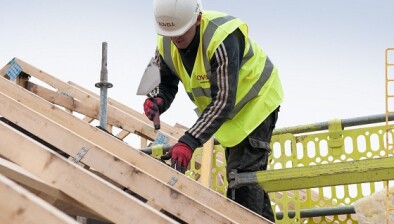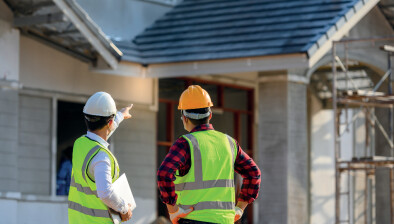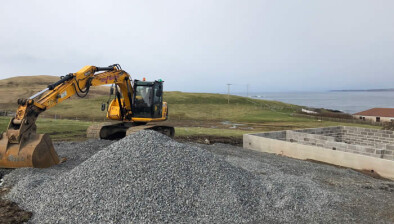Construction downturn eases in December

Activity in the UK construction sector fell again in December, although the rate of decline eased to the slowest since the current phase of decline began last September.
A sustained slump in house building was the main factor holding back construction output, which survey respondents linked to elevated interest rates and subdued confidence among clients.
Improving supply conditions continued in December, with delivery times for construction items shortening for the tenth month in a row. Price discounting among suppliers contributed to a moderate fall in average cost burdens across the construction sector at the end of 2023.
At 46.8 in December, the headline S&P Global UK Construction Purchasing Managers’ Index (PMI) was below the neutral 50.0 mark for the fourth month running. However, the index was up from 45.5 in November and the highest for four months.
House building remained the weakest-performing category of construction work in December (index at 41.1), despite the rate of decline easing to its slowest since July 2023. Civil
engineering activity (index at 47.0) also posted a softer pace of contraction at the end of last year.
Commercial construction meanwhile declined only modestly (index at 47.6), but the speed of the downturn accelerated to its fastest since January 2021. Some firms noted that
concerns about the domestic economic outlook, alongside elevated borrowing costs, had led to greater caution among clients.
Total new work decreased at the slowest pace since the current period of decline began in August 2023. Subdued customer demand across the house building sector was often cited as a factor leading to reduced order books.
A softer decline in new work and hopes of a turnaround in demand conditions during 2024 contributed to a renewed rise in employment numbers in December. However, the rate of job creation was only marginal.
Mirroring the trend for construction output, latest data indicated the slowest fall in purchasing activity for four months. Where a decline in input buying was reported, this often reflected a lack of new work to replace completed projects.
Lower demand for construction products and materials resulted in shorter wait times for suppliers’ deliveries in December. Improving vendor performance has been recorded in each month since March 2023. Survey respondents often noted that competition for market share among suppliers had led to price discounting at the end of last year. Average cost burdens across the construction sector decreased for the third month running in December, albeit only modestly and at the slowest pace during this period.
Finally, latest data indicated somewhat upbeat business expectations at UK construction companies for output levels during the year ahead. Around 41% of the survey panel anticipate an increase in business activity over the course of 2024, while only 17% predict a decline. Anecdotal evidence suggested that subdued forecasts for the UK economy were a key concern, while hopes of reduced interest rates and a turnaround in market confidence were factors cited as likely to boost construction activity.
Tim Moore, economics director at S&P Global Market Intelligence, which compiles the survey, said: “Construction companies experienced another fall in business activity at the end of 2023 as weak order books meant a lack of new work to replace completed projects. House building was the worst-performing area of construction activity, but even in this segment there were signs that the downturn has started to ease.
“Elevated borrowing costs and a subsequent slump in market confidence were the main factors leading to falling sales volumes across the construction sector in the second half of 2023. Survey respondents also continued to cite worries about the broader UK economic outlook, especially in relation to prospects for commercial construction.
“However, expectations of falling interest rates during the months ahead appear to have supported confidence levels among construction companies. December data indicated that 41% of construction firms predict a rise in business activity over the course of 2024, while only 17% forecast a decline. This contrasted with negative sentiment overall at the same time a year earlier.”
The Federation of Master Builders (FMB) believes there is a glimmer of hope for 2024 despite the continued decline in construction activity.
Brian Berry, chief executive of the FMB, said: “December’s Construction Output data once again shows a continued decline in house building rates, with commercial construction rates also down. There are, however, positive signs that the rate at which activity within the industry is declining is starting to slow, giving hope that 2024 may be a year when we finally start to see improvement. If the government is serious about substantially boosting the UK’s house building rates and the wider construction industry, it must look at this as an opportunity to make real progress.
“In recent months the government has taken some modest positive steps - providing tax cuts which will benefit small businesses and introducing new proposals for how the planning process can be expedited. Today’s announcement shows promising signs that the measures will have a positive impact, but the government must not take this as ‘job done’. House building rates are still continuing to decline, and a comprehensive action plan is necessary if the UK is to deliver on the increased confidence of construction companies that 2024 will bring a rise in business activity.”
Brian Smith, head of cost management and commercial at AECOM, added: “The traditional December slump in activity – fuelled by stormy weather and a quiet festive season – won’t itself concern the industry. But it was another month of decline for a sector struggling for momentum, and positive signs are currently hard to come by.
“Construction firms are at a heightened risk of insolvency over the next 12 months and this is particularly true for housebuilders, with high borrowing costs and expected falling house prices continuing to dampen the market.
“With a general election on the horizon, firms across the sector will be hopeful of the wider economy gaining fresh impetus. For the time being though, it’s critical that supply chains work collaboratively to avoid the knock-on effects of individual contractors running into challenges.”

















